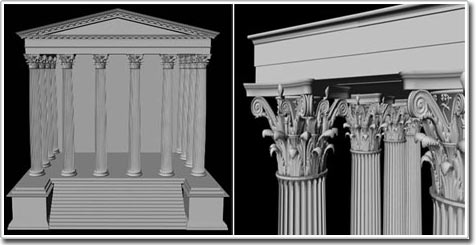Recreate the first temple of Rome by digital
Scientists have recreated Rome's earliest main temple - the Apollo sun god temple, thought to have been built by the first Roman emperor Augustus. This temple dates back to 28 BC, its ruins lie in front of the Emperor's palace complex on the famous Palatine hill, where the legendary cave of Rome is discovered.
So far, people have not fully understood the temple's original design, partly because of the poor preservation status of the ruins. Furthermore, previous attempts to replicate the temple were based on outdated historical assessments rather than ruins themselves.
Stephan Zink, a graduate student at the University of Pennsylvania, surveyed this area and the remaining archaeological ruins to produce new calculations and other data that could accurately recreate the temple.'This reconstruction work offers completely new reference points - not only for archaeologists and scholars studying the Augustus temple design, but also for the ancient historians and old houses. classics. '
The Augustus period of the Roman Empire stretched from 43 BC to 18 AD, the flourishing period of science, politics, technology and architecture. The Temple of Apollo is the first temple project of Augustus and plays an important role for the Emperor in protecting his power.
Zink said: 'The new reconstruction project closes an important gap in human knowledge of the architectural history of this era and opens up the possibilities of re-evaluating many aspects of the Augustus culture.'
Zink presented his findings at the January meeting of the American Archaeological Institute.

Digital photo shows the reconstructed façade of the Apollo Sun Temple (top left) and details of the columns (top right) - (Photo: National Geographic)
Past and present
Zink undertook work at Palatine Hill from 2005 to 2007. He studied the remnants of the temple and the pieces of marble scattered in the area. All the remains of today are large in size and may be Roman concrete blocks, once the central area of the temple's foundation.
The parts of the foundation that supported the pillars and the wall built of aggregate stones, known as rocks made of volcanic ash, have disappeared completely. But some pieces of architecture such as an area of intersection of integrity columns exist and are located throughout the area.
By combining real-world data and previous studies from the 50s and 60s, Zink can restore the majority of the temple's key metrics and re-enact the region digitally. .'When looking at this area today, it's hard to imagine that this place once had a high temple equivalent to a 10-storey apartment.'
Reconstruction works
Zink's new research reconstructs the primitive location of each column and places the remaining pieces of rock in the right position. When implementing the reconstruction work, he also carefully considered the design plans of Marcus Vitruvius Pollio, a famous Roman engineer and architect under Augustus.
The facade of the building, according to the new model, shows a structure originating from the local tradition with similarities to the famous Hellenistic and Greek temples, works that people consider to be influential. on Vitruvius's work.
Zink said: 'As long as this temple exists again, the implementation of an extensive assessment of its design is possible. For the first time, questions such as: What design does it emulate? How does this work compare to other Roman Empire temples ?, The symbolic meaning of the temple design in What is its historical and political context? Can be answered based on actual data from the work. '
Birte Poulsen, an archaeologist at Aarhus University in Denmark, thinks that Zink's work has brought very important information about Roman structure in the beginning.
'The methods seem convincing and Zink is having positive results. The Temple of Apollo is one of the most important works since Augustus. Further knowledge of the Temple of the Apollo Sun Temple will help us learn more about architecture in Augustus in general, and Roman architecture in Augustus in particular. '

Ruins of the temple today.(Photo: National Geographic)
- Recreate Rome in 1 day
- The truth falls back on the culprit who burned into Rome
- Famous buildings are
- Temple in Arles
- The temple is dedicated to Rome as if it was under volcanic ash 2,000 years
- Mysterious labyrinth under Rome
- Mystery of temples 'timeless' in India: There is a value of up to 100 billion USD!
- Wild carrying earthquake news in Rome
- Discovered 3,000-year-old megalithic temple in Peru
- Discovered a thousand-year-old Cham temple complex
- Found a 5,000 year old stone temple
- Italy: 'Reconstructing Roma' in the digital world
 Discovered an ancient centipede fossil 99 million years old
Discovered an ancient centipede fossil 99 million years old Discovered bat-like dinosaurs in China
Discovered bat-like dinosaurs in China Discovered a 200-year-old bronze cannon of the coast
Discovered a 200-year-old bronze cannon of the coast Discover 305 million-year-old spider fossils
Discover 305 million-year-old spider fossils Why does a strange rain always fall on an 1800-year-old temple every June?
Why does a strange rain always fall on an 1800-year-old temple every June?  Ruins of an ancient temple dating back to the Ptolemaic period discovered in Egypt
Ruins of an ancient temple dating back to the Ptolemaic period discovered in Egypt  Gravity Defying Pillar in Indian Temple
Gravity Defying Pillar in Indian Temple  The Mystery of the Temple of Baalbek, Where Modern Technology Cannot Replicate the Construction Process!
The Mystery of the Temple of Baalbek, Where Modern Technology Cannot Replicate the Construction Process!  Revealing the mystery of a 2,700-year-old bronze shield and helmet
Revealing the mystery of a 2,700-year-old bronze shield and helmet  Legend of the first woman to be an Egyptian pharaoh
Legend of the first woman to be an Egyptian pharaoh 